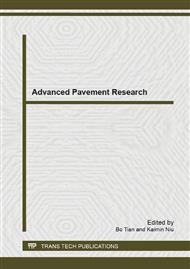p.3
p.10
p.20
p.27
p.35
p.42
p.51
p.56
Study on Vibrational Liquefaction Behavior of Air-Entrained Concrete
Abstract:
With respect to the liquefaction behavior of cement concrete material in a vibrational condition, the varying patterns of the vibrational viscosity coefficients, vibrational energy transfer and rheological mechanical behavior of air-entrained concrete and non-air-entrained concrete in a vibrational shear condition were compared by analyzing the vibrational liquefaction processes of concrete. The study has found that the vibrational viscosity coefficient of concrete with air entraining agent added increased notably so that air-entrained concrete can maintain good shuttering behavior during slip-form construction; presence of a large number of tiny bubbles in air-entrained concrete allowed more even transfer of vibrational energy in concrete; and the rheological mechanical behavior of concrete was improved after air entraining agents were added so that it became easier to liquefy by vibration and had better shaping effect upon completion of vibration. Keywords: air-entrained concrete, slip-form construction, cement concrete pavement, vibrational liquefaction
Info:
Periodical:
Pages:
20-26
Citation:
Online since:
December 2013
Authors:
Price:
Сopyright:
© 2014 Trans Tech Publications Ltd. All Rights Reserved
Share:
Citation:


